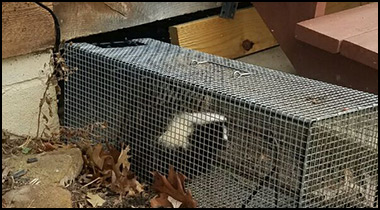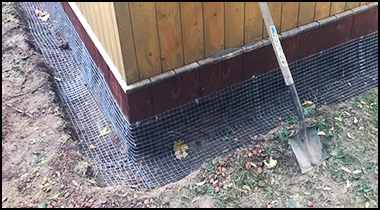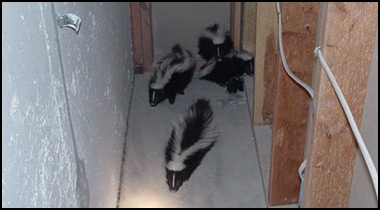Annapolis Skunk Removal Resources
Skunk Rehabber - Davidsonville Wildlife Sanctuary: (410) 798-0193
Free Anne Arundel County Animal Services: 410-222-8900
Humane Wildlife Trappers of Annapolis: 410-774-5789
If you need skunk control in Annapolis, you have a few options. First, you can attempt to solve the skunk problem yourself by reading our do-it-yourself guide. If you need outside help, you can also call Anne Arundel County Animal Services to see if they have any free resources or help for you - however, they primarily deal with dog and cat concerns. You can also call a local Annapolis wildlife rehabber, as they are typically a great resource for advice that is in the best welfare of the animal. If as a last resort you must hire a professional company, we recommend Humane Wildlife Trappers of Annapolis at 410-774-5789. To learn more about them or check their skunk removal prices, visit annapolispestanimal.com.

Annapolis Skunk Trapping and Removal

Preventative Repairs & Exclusion

Annapolis Skunk Removal From Structures
In many cases, preventative measures can solve your Annapolis skunk problem - keep garbage secured, pet food indoors, and most of all when it comes to skunks, secure the perimeter of your shed, porch, deck, or house with a barrier - lattice or steel mesh is good, and it keeps Maryland skunks from going under the structure. If trapping and removal of the skunk is the only option you have, please do so with the help of a local agency or professional company who knows how to do it humanely and legally. Browse the resources of this site for more educational information.
Frequently Asked Questions:
Prevention: How to Keep Skunks Away
What to do with a skunk after I catch it?
Is it legal for me to trap a skunk?
How to remove skunk odor
Is a skunk active during the daytime rabid?
What does skunk feces look like?
Annapolis Skunk Control Information: How to identify skunk tracks
The common striped skunk is a crepuscular (meaning they hunt at dark and dawn) animal. The Skunks primary means of defense is its odiferous anal spray. The pair of glands located beneath its tail is filled with a musky smelling mixture. This concoction is methyl mercaptan and sticks to whatever it is sprayed on. A skunk has enough spray to repeat the action up to six times in one attack. Skunks also tend to stomp their feet, hiss, spin, and raises their tail over their head when it is confronted with danger. If you think you have a skunk problem, they best way to identify the skunk is to see it, but there are other ways. You might notice a distinct skunk smell about, or you might identify their conical holes scattered around your yard.
Another mean of positive identification is their tracks. The tracks of a skunk reveal that it has 5 toes on its front foot as well as its hind foot. Front tracks have long claw marks extending out ahead of the toe farther than those on the rear feet do. Usually only the heel or metacarpal pad of the skunk's front track is visible. In the tracks of a skunk, the carpal, or toe pads are not normally visible. It is most likely because of the way a skunk walks with a swagger. Now, want to know how to tell a left print from a right? When you examine the tracks, you will see that a toe will be smaller and sits lower in the track. This is the inner toe, or toe 1.
On tracks toes are numbered starting from the inside out, numbered 1 to 5. Following this logic, location of Toe number 1 tells you this toe are closest to the inside of the animal's body. Think of it as the equivalent of your thumb when you know that toe's position, you can tell which foot you are looking at. You will know it is the front foot because bears longer claw marks. The same is true for the back feet. Although this method of identification might sound complicated, it will become apparent as soon as you see your first skunk print
Remember, for free services you can try (410) 798-0193 or 410-222-8900, but if you need to pay for professional help, check the prices at the annapolispestanimal.com website. Or follow our do-it-yourself guide!

